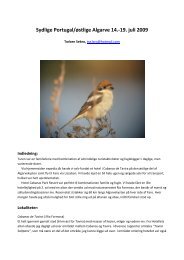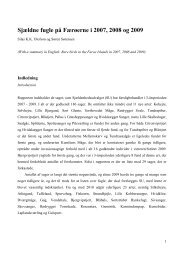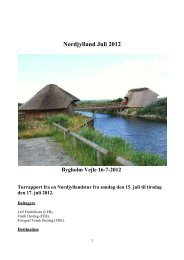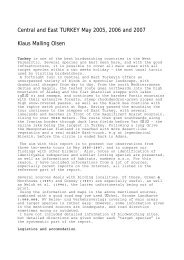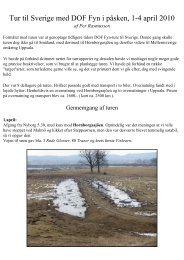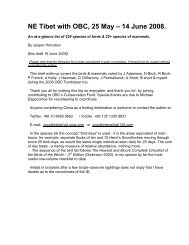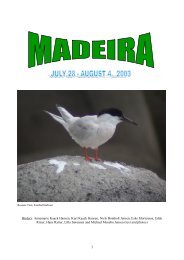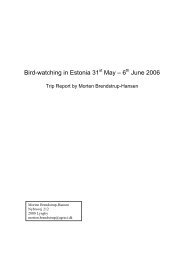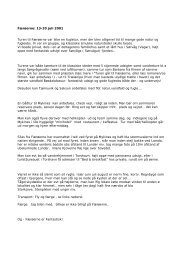Rockjumper Birding Tours - Netfugl.dk
Rockjumper Birding Tours - Netfugl.dk
Rockjumper Birding Tours - Netfugl.dk
Create successful ePaper yourself
Turn your PDF publications into a flip-book with our unique Google optimized e-Paper software.
12<br />
Friday May 20 th : North Luzon, Camp 1, trekking back to Baliwag, then flight to Puerto Princesa<br />
in Palawan from Tuguegarao, via Manila.<br />
A fine birding morning at Camp 1 from 5 to 6.40 am. A pair of Sooty Woodpeckers showed well<br />
in a fork of a big tree. Bar-bellied and Blackish Cuckoo-shrikes, Rufous Hornbill, Black-andwhite<br />
Triller, Luzon Striped Babbler, and White-lored Orioles.<br />
The walk back to Baliwag through open grassland country was much easier this time. First of all, it<br />
was a cool morning, and the sun was still low on the sky. It made a huge difference. We all saw a<br />
flock of Green-faced Parrotfinches well. Other birds along the route were Whiskered Tree-Swift,<br />
Blue-tailed and Blue-throated Bee-eaters, Pied Bush Chats, Long-tailed Shrikes and a Rufousbellied<br />
Eagle at Baliwag.<br />
From Baliwag we drove to the airport of Tuguegarao, and caught a plane via Manila to the paradise<br />
island of Palawan in the southwest part of the archipelago, which was our next destination on our<br />
incredible journey.<br />
The island of Palawan is situated not far from the Bornean coast. Palawan is a long, narrow island,<br />
thinly populated and almost completely covered by forest. It has beautiful landscapes, and is<br />
characterised by a central mountain range of limestone cliffs. Although this island is comparatively<br />
small, it is truly blessed with birds, holding no fewer than 16 endemic bird species! The most<br />
famous is Palawan Peacock-Pheasant – one of the most beautiful pheasants in the world, and the<br />
flagship species of Palawan. Apart from the endemic birds, Palawan holds a number of widespread<br />
South-East Asian bird species, that can be seen only on this island in the Philippines.<br />
We landed in the island capital Puerto Princesa at 16.40 pm. During landing, Erling spotted an<br />
unidentified Frigatebird over the sea from the plane, either Greater or Lesser Frigatbird.<br />
Palawan was hot, humid and very lush and green. Our local guide Arnel Mallari welcomed us in the<br />
airport, and took us straight to our comfortable hotel in town. After a short break, we made a brief,<br />
late afternoon visit to the coast at a mangrove area. A White-vented Shama was sitting on a<br />
telephone wire – our first Palawan endemic. At the beach there were Stork-billed and Whitecollared<br />
Kingfishers, Great Crested Tern, and the waders Greater Sandplover, Gray-tailed<br />
Tattler and Whimbrel. A Hooded Pitta was calling from the mangrove vegetation, along with<br />
Pied Fantails.<br />
Saturday May 21 st : Palawan, birding along drive from Puerto Princesa to Sabang, and in Sabang<br />
We left Puerto Princesa at ten to six in the morning, and drove towards Sabang straight across the<br />
narrow island to the coast on the north side. During our drive to Sabang we passed through good<br />
primary and secondary forest, and made a number of rewarding stops. Good views of no less than<br />
eight Palawan endemics Palawan Flowerpecker, Lovely Sunbird, Yellow-throated Leafbird, the<br />
lovely Palawan Tit, Sulphur-bellied Bulbul, 5 Palawan Hornbills, the magnificent Blue<br />
Paradise-Flycatcher and a pair of Palawan Blue-Flycatchers. A pair of Oriental Hobby plus a<br />
third chased each other in display over the forest road.<br />
Lovely Sunbird – endemic to Palawan<br />
The endemic Palawan Tit




